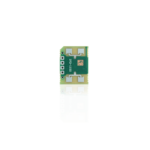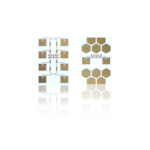Easily switch from 10 GHz to 24 GHz
– the switch from X-Band to K-Band radar technology.
Innovation in the 10 GHz sector has stagnated for a few years now. Even radar products primarily used for simple motion detection are interested in greater technological advances offered by 24GHz. A possible reason for this is that the functionality and performance of 10 GHz sensors has been exhausted and cannot be further optimized. A question to be considered is why are 10 GHz radar solutions still popular?
The answer: The price is a crucial criterion for motion sensor manufacturers. The 10 GHz radar components are extremely cheap. This is to the low development overhead and the low level of complexity and performance.
The components and materials are also inexpensive – production and material costs have been reduced over the years. Innovations are only made through changes in binding regulations or advances in software or production materials. 10 GHz solutions have been established for many years and are geared toward the low-budget mass market. The sector is barely growing due to a lack of further developments.
Competitive prices & technical progress opens up new perspectives.
One alternative is 24 GHz radar solutions. They are also ideal for simple motion detection. Switching from 10 GHz to 24 GHz would be ideal because the measurement method would remain the same, merely the frequency would change. The manufacturers would continue to benefit from the advantages of radar technology and can carry make the sensor technology switch without having to build up complex skills (such as the switch to PIR).
24 GHz sensors usually offer more functionality. However, this makes the products more complex and more expensive. But a lot has happened in recent years. The prices of 24 GHz products are falling and the variety of applications is growing. The technology is no longer only attractive to industries such as security technology, which demand maximum performance and functions. Many manufacturers are willing to invest more to ensure better performance & technological advances.
- Many manufacturers are faced with questions: Is it worth switching?
- How expensive would it be for me to make the switch? What changes do I need to make?
This article supports them to find answers. Starting with an overview of technological differences and continuing with a list of necessary changes, you will find it easier to weigh things up.
Properties of 10 GHz & 24 GHz sensors
For a better technical understanding, below is a brief overview of the different characteristics of 10 GHz and 24 GHz radars. Simply put, they use different frequencies and wavelengths. 10 GHz sensors operate at a lower frequency in the X-band and thus have longer waves. 24 GHz radars work in the K-band at a higher frequency and therefore have shorter wavelengths. See here for more detailed information on the effects:
In general, these are the following technical differences between 10 GHz and 24 GHz:
In our expert interview you will receive more information about 10 GHz and 24 GHz radar sensors.
Due to the benefits mentioned above, making the switch is well worth it for many technology companies, especially if they want to make their products more advanced and functional. The switch is even more attractive because the price level of the latest 24GHz sensors (e.g. IMD-1100 from InnoSenT) is hardly any higher than 10 GHz products.
To 24 GHz in just a few steps
One final hurdle remains: the overhead involved in establishing the new technology. However, this is also extremely low. There are only a few aspects to consider when making the switch. These aspects can be divided into mechanical and technical changes.
Mechanical transformation
-
-
- Most 24 GHz sensors have more than one output. This is used, for example, to output motion directions on different channels. When making changes to the product design, it is important to consider that
- 24 GHz radars are much smaller. The space saving makes it possible to reduce the size of the end product or the housing. There is also no need for the cover on the back, which is required for 10 GHz sensors.
- Adjustments to the radome also need to be made. Our guide regarding the construction of a radome for 24 GHz sensors can also help.
- The field of view may differ significantly due to the different antenna designs. In this case, the product should be selected based on a similarly designed detection range or its adaptability in order to obtain a comparable detection range.
-
Technical changes
-
-
- Due to the frequency change, adjustments need to be made to existing filters. The calculations must be increased by a factor of 2.4.
- The antenna gain needs to be optimised accordingly – depending on the application scenario.
- When switching from 10 GHz to 24 GHz, integrators should also consider making circuit changes.
- The reference design of a 24 GHz sensor can provide assistance. For example, InnoSenT provides suitable documents for products such as the SMR series. Using the reference design, integrators can directly implement the displayed circuit diagram for the selected product.
-
Simplified representation of the circuitHigh-pass amplifier with capacitor C1 and resistor R1 Low-pass amplifier with capacitor C2 and amplifier resistor R2 Positive supply voltage Vcc (e.g. operating voltage 5 V) Positive supply voltage for the operational amplifier Vcc/2
Calculation of the change due to higher frequency High pass filter fH = 1/(2π*R1*C1) can be increased by a factor of 2.4 Low pass filter fL = 1/(2π*R2*C2) should be increased by a factor of 2.4
Switching from 10 GHz to 24 GHz involves little development overhead and is easy to implement for experienced radar users. The mechanical and technical changes are minimal. The biggest task involves design, if the integrators are considering making adjustments to the housing.
In addition, there may be improvements in logistics and production. State-of-the-art production processes such as SMT assembly increase processing efficiency and speed up manufacturing. Thanks to the harmonised frequency band with 24 GHz, country-specific product variants are no longer necessary. The manufacturer can streamline its portfolio.
If you put the advantages gained (more efficient production and logistics, greater functionality and better performance) into perspective, the overhead involved is negligible. So it is worth considering making the switch and relying on the promising 24 GHz technology.
Share This Content
InnoSenT product recommendations for motion detection
– Alternative to 10 GHz sensors
Radar Front end IMD-1100
 The CW-Radar module is InnoSenT’s smallest and cheapest product. It reliably detects movements, determines the direction of movement and the speed within a detection range of up to 15 metres. The field of view and the pin assignment are optimally adapted for replacing 10 GHz sensors.
The CW-Radar module is InnoSenT’s smallest and cheapest product. It reliably detects movements, determines the direction of movement and the speed within a detection range of up to 15 metres. The field of view and the pin assignment are optimally adapted for replacing 10 GHz sensors.
SMR radar product series
 InnoSenT’s SMR series is suitable for SMT assembly. This product was the world’s first pick & place-capable radar modules. The individual radar sensors differ in their antenna design in order to provide the optimal direction of vision in different installation positions. The series includes two products with CW radar modulation and two FMCW sensors. In addition to the direction of motion and speed, the latter also provide distance information.
InnoSenT’s SMR series is suitable for SMT assembly. This product was the world’s first pick & place-capable radar modules. The individual radar sensors differ in their antenna design in order to provide the optimal direction of vision in different installation positions. The series includes two products with CW radar modulation and two FMCW sensors. In addition to the direction of motion and speed, the latter also provide distance information.
Get this technology on your radar
Information on this advanced sensor technology
The demand for sensors is increasing due to trends such as digitalisation, automation in industry & logistics, smart homes & cities, and autonomous driving. But the development and integration of radar units is a complex topic, and the technical terms and functions raise many questions for users. Our radar experts have put together comprehensive information to help you get started in the world of radar.


